The intensity and variety of tasks performed by the Special Operations Forces (SSO) require the use of first-class standard equipment, as well as specially designed equipment. Despite the fact that the MTR is already one of the most well-equipped categories of forces in any army, they are constantly looking for new or improved tools that would provide them with a tactical advantage.
Small arms
The wide range of tasks facing special forces units requires the purchase of various weapons optimized for different modes of warfare and ranges. This is evidenced by the ongoing work on the modernization of the units of the Joint Forces of the Land Forces and the German Navy – Kommando Spezialkräfte (KSK) and Kommando Spezialkräfte Marine (KSM) , respectively.
In a nutshell, KSK and KSM are replacing their current pistols with the new Walther P14 and compact P14K. The supply contract was announced in May 2024 and is designed for seven years. It provides for the supply of up to 6,500 pistols, as well as accessories, spare parts and training systems.
The P14 is based on the Carl Walther AG 9 mm Service pistol (PDP). Accessories for the P14/P14K include silencers, compensators, red dot sights and laser designators, as well as standard (18-round) and long magazines. This weapon is suitable for use at sea.
German Special Forces Sniper Rifles
KSK has recently upgraded the G22 and G22A1 long-range (1,200 m) sniper rifles to the G22A2 standard. The G22A2 rifle is equipped with a muzzle brake, which reduces recoil by half, reduces the pull on the trigger, as well as upgraded optical sights equipped with a night vision adapter. Other optional accessories include a silencer, a red dot sight, and a ballistic calculator with a built-in weather monitor.
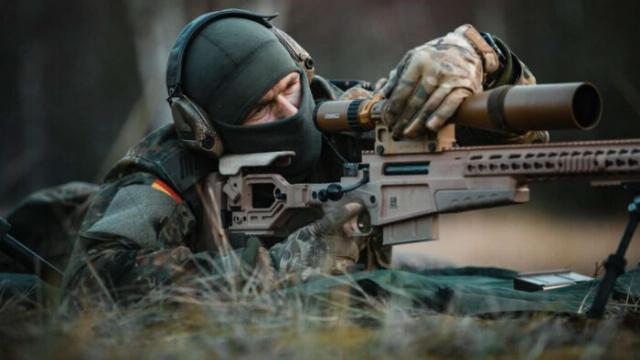
KSK sniper with G22A2 rifle
The G210 model is positioned as a "sniper rifle for close combat" and is a variant of the MR308 A6, developed by H&K specifically for the MTR tender announced by the German KSK. With a maximum length of 1010 mm (including a 425 mm barrel) and a weight without cartridges of 4.4 kg, the semi-automatic precision-firing weapon is suitable for use in various conditions, including in the city. About ordering up to 500 units. KSK and KSM were announced in August 2024. According to recent statements from H&K, the exact delivery schedule is still being discussed, but it is expected to begin in 2025.
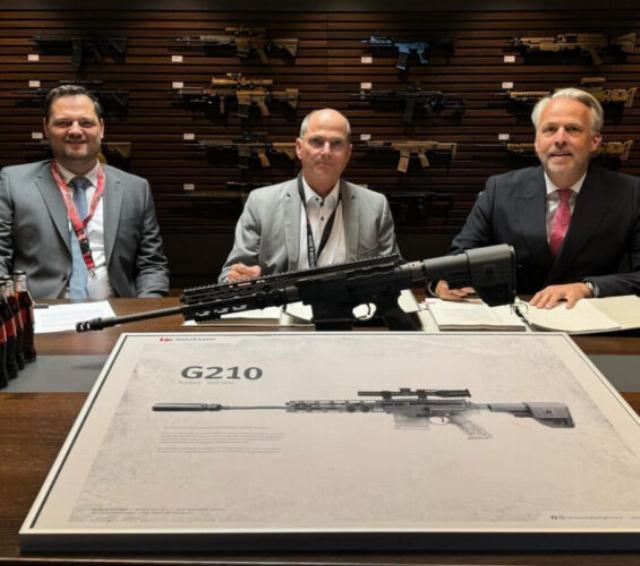
Representatives of the German defense procurement agency BAAINBw (in the center) and Heckler & Koch signs contract to supply G210
Compact Assault Rifle
KSK and KSM are also purchasing two new types of firearms for use at short and medium ranges.
The Heckler Company & Koch defines the G39 as a compact assault rifle that can be used as a submachine gun (PP). The new "specialized silent weapon for special forces" based on the HK437 will have a longer range and stopping power than the MP5D it replaces.
The weapon will be chambered for 7.62×35 mm (.300 AAC Blackout). In the G39 configuration, it will have a 229 mm long barrel with a retractable stock. The G39 will be equipped with an A-TEC silencer. With the silencer installed and the butt fully extended, its length is 926 mm. The weight without cartridges with a silencer and an empty magazine is 3.3 kg. Overall, this weapon is highly maneuverable in close combat and is superior to the MP5 in open terrain combat.
While H&K indicates that the effective range of a 9x19mm submachine gun is about 100 m, the effective range of a 7.62×35mm assault rifle can reach 300 m. In February 2024, the purchase of the first batch of 176 units was announced. Although deliveries will begin in 2025, up to 988 units of equipment will be required in total.
US MTR machine guns
Due to budget constraints, in October 2024, the US Special Operations Command (USSOCOM) suspended the search for a new sniper rifle for shooting at extremely long distances (more than 2,500 m), but continued to implement other weapons acquisition projects.
These include the M2HB light machine Gun (Lightweight Machine Gun – Medium, LMG-M). The model is designed to complement and bridge the capability gap between the 12.7×99 mm (.50 BMG) M2HB (HMG) heavy machine gun with a maximum effective range of about 2,000 m and the 7.62×51 mm M240 (GPMG) general purpose machine gun with a maximum effective range of about 800 m.
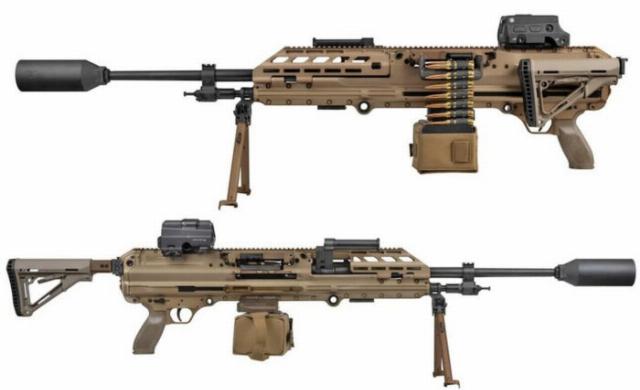
Participant of the LMG-M Sig Sauer MG 338 competition
The LMG-M will be chambered for 8.6×93.5 mm (.338 Norma Magnum). The Special Operations Command hopes to achieve accuracy at ranges comparable to a 12.7mm heavy machine gun, while maintaining the weight and mobility of the M240. This requirement goes back to the experience of the MTR in Afghanistan, where enemy fighters using non-standard PKM machine guns firing 7.62×54R ammunition (with a rim) reached a firing range of up to 1,500 m, which significantly exceeds the capabilities of the M240. The new weapon is intended for dismantled MTR weapons, as well as for installation on light vehicles and boats.
SOCOM initiated the LMG-M program in 2017 to ensure superiority over enemy forces in the future, and initially hoped to conclude contracts in 2021. The three remaining contenders for the contract – Sig Sauer, True Velocity (together with FN America) and Ohio Ordnance Works – delivered their first SOCOM prototypes for testing in February 2024. As SOCOM confirmed in March 2025, the LMG-M program is still undergoing supplier selection. The command intends to announce its decision in the summer of 2025.
Planning and barrage ammunition
Sometimes, of course, 2000 m is not enough. Given the requirements for stealth and mobility of special forces, any long-range weapon should be easily portable both on foot and on light vehicles. To this end, USSOCOM is requesting industry applications for a precision-guided planning munition that is smaller than the GBU-69 small planning munition and that can be delivered by unmanned aerial vehicles (UAVs).
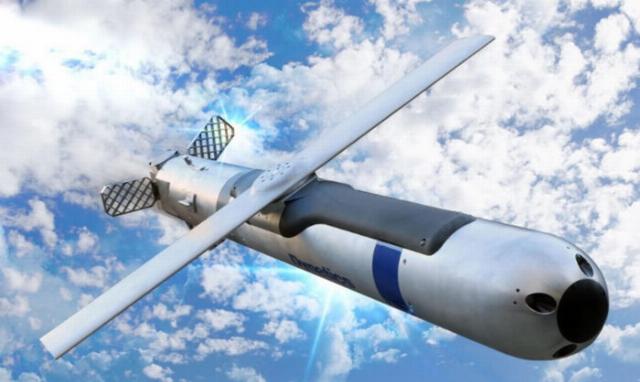
GBU-69 Small Gliding ammunition
In February 2025, the USSOCOM technology incubator, a non-profit organization called SOFWERX, invited industry representatives to an evaluation event in April 2025 "to present, demonstrate, and/or discuss their solutions." Subsequent evaluations conducted by USSOCOM may lead to research and development agreements and prototype testing. Currently, the target weapon is designated as a Gliding Offensive Lightweight Unmanned Munition (GOLUM).
According to publications, the GBU-69 has a length of 107 cm and weighs 27 kg, including a warhead weighing 16.4 kg. The range exceeds 32 km. The stated target criteria for the GOLUM include a maximum mass of 13.2 kg and a range of 100 km or more, as well as modular warhead options, including for aerial detonation, impact and penetration.
Situational awareness sensors and tools
Regardless of whether it's hostage rescue, direct action, or intelligence, the tasks of the special forces depend on awareness of the situation. A wide range of tools is required.
Throwable sensors
The Recce 360 tactical camera manufactured by Bounce Imaging is designed to capture 360° circular video and audio in any environment. The spherical camera can be thrown like a baseball. The sensor is designed to provide special forces with reliable information about the situation in difficult scenarios (hostage rescue and counter-terrorism operations), while maintaining the secrecy of personnel. In addition, the device can be mounted on a pole, lowered on a cable, or mounted on a reconnaissance UAV or an uninhabited ground vehicle.
The Recce 360 product is available in two versions: the Recce 360 TW weighing 770 g and the Recce 360 Mini weighing 360 g. Both variants feature six monochrome cameras evenly spaced throughout the sphere to ensure full coverage no matter how the ball lands.
The system is also equipped with a microphone and speaker for two-way communication, as well as white light LEDs that can flash to disorient enemies before attacking. The Recce 360 can be remotely controlled using a tablet or smartphone app and real-time images can be transmitted to the operator and three other team members. Depending on the option, the transmission range and battery life reach 123 m and two hours, respectively.
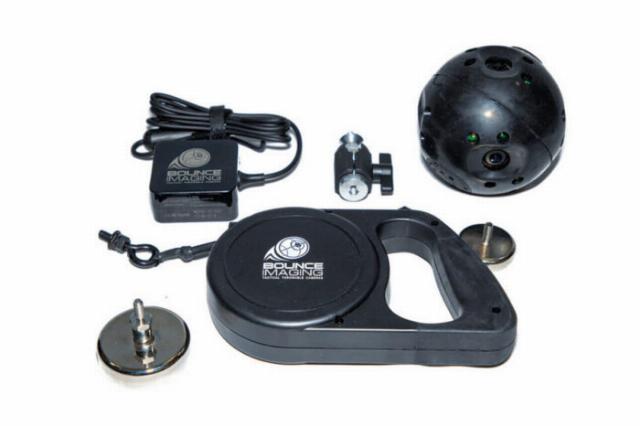
Recce 360 Throwable Sensor and Accessories
In September 2024, Bounce Imaging announced the addition of the Pit Viper 360 to its product line. The company describes this grapefruit-sized device as "the world's first tactical throwable thermal imaging camera with 360° view." Unlike the Recce 360, which provides an additional thermal imaging feature, the Pit Viper combines six thermal imaging cores and an inertial measurement Unit (IMU) to create a dedicated thermal imaging video sensor.
Target exploration
To perform reconnaissance and targeting tasks, the US military selects means from various combinations of optical sensors and fire support systems.
One of the solutions is the Sterna True North (Sterna TNF) surveillance device from Safran Vectronix AG. The product can be interfaced with a number of optoelectronic devices of the company to obtain accurate guidance coordinates. The Sterna TNF can operate in the absence of Global Satellite Navigation System (GNSS) data and in any terrain, including indoor areas. Typical applications include reconnaissance, fire control, close air support, and search and rescue (SAR) operations.
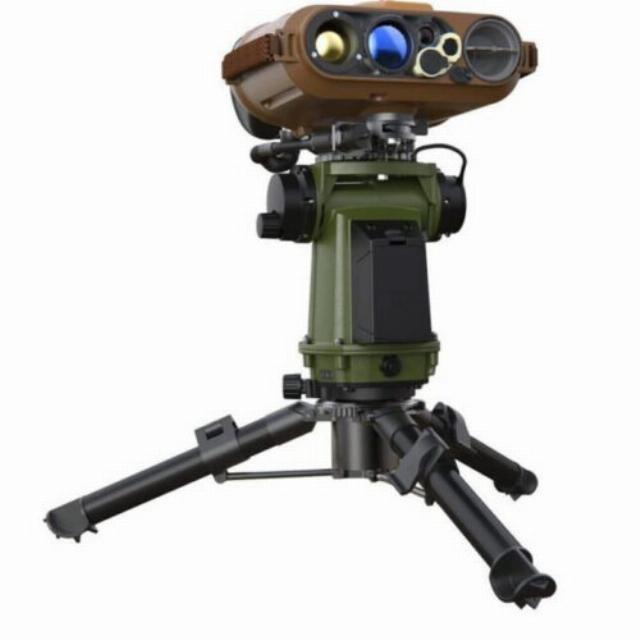
Safran Sterna TNF with integrated optoelectronic device Moskito
The key features reported by the manufacturer are: determining your own location, determining the true magnetic north, and accurately calculating the coordinates of the target. The basic system is available in two versions: the Sterna TNF 45 and the Sterna TNF 60. Both variants are very portable, with the larger TNF 60 weighing about 3.2 kg (without the connected optoelectronic sensor, which can weigh up to 3 kg).
Guidance data is transmitted with CAT I or CAT II accuracy, depending on the distance to the target and the built-in optoelectronic device. The longest-range solution is achieved by installing the Safran JIM LR multifunction day/night binoculars or the Mosquito optical sensor on top of the Sterna TNF.
Both devices are equipped with a laser rangefinder that provides CAT II accuracy at a distance of 10,000 m to the target. The coordinates and images of the targets are transmitted via Bluetooth.
Tunnel exploration
In March 2025, USSOCOM placed a request for a contract for first-person view (FPV) drones specifically designed for use in tunnels, caves, and other enclosed spaces. The name of the chosen supplier has not yet been disclosed, but SOCOM said that only one company is able to provide both the necessary drones and appropriate operator training.
The tender is specifically aimed at the US MTR groups of category "A" ("green Berets") operating in the area of responsibility of the Central Command, although they can be provided to other Special Forces forces. As stated in the command's request: "Currently, the lack of dedicated UAVs for cave clearance operations forces us to rely on military Service Dogs (MWD) or partner forces, which significantly increases the risk to both personnel and mission success. Caves are enclosed, complex spaces with limited visibility and unpredictable terrain, which increases the danger to personnel and potentially reduces the effectiveness of the MWD."
The exact nature of the acquired UAVs remains unknown. Drones with a fiber-optic cable as a conductor would ensure maximum reliability of real-time feedback, since conditions inside caves and tunnels can interfere with the wireless repeaters of autonomous UAVs. In particular, units of the Israeli Armed Forces have gained significant experience in using UAVs with fiber-optic cables in extensive labyrinthine tunnel systems, where there are many opportunities for setting booby traps and ambushes.
Mobility systems
The Marine special operations forces have special requirements for covert penetration underwater. In addition to combat swimmer delivery vehicles (SDVs), these include customized underwater vehicles such as the Jetboots Propulsion System from Patriot3. According to the manufacturer, this system is used by the armed forces of 25 countries, including the US Navy, the US Marine Corps and units of the special operations forces of the US Army. In April 2022, USSOCOM ordered additional units of equipment under a contract for an indefinite period and in an indefinite quantity (IDIQ) in the amount of 10 million US dollars with a delivery period of up to five years.
The traction battery and the system control device are attached to the diver's belt and connected by cables to two traction nozzles, which are attached to the diver's hips. The adjustable nozzles are powered by low-noise DC motors. The system can reach speeds of up to 7.2 km/h (3.9 knots) and operate at depths of up to 92 m. The lithium-ion battery provides enough power to operate for six hours, while the actual operating time depends on the speed.
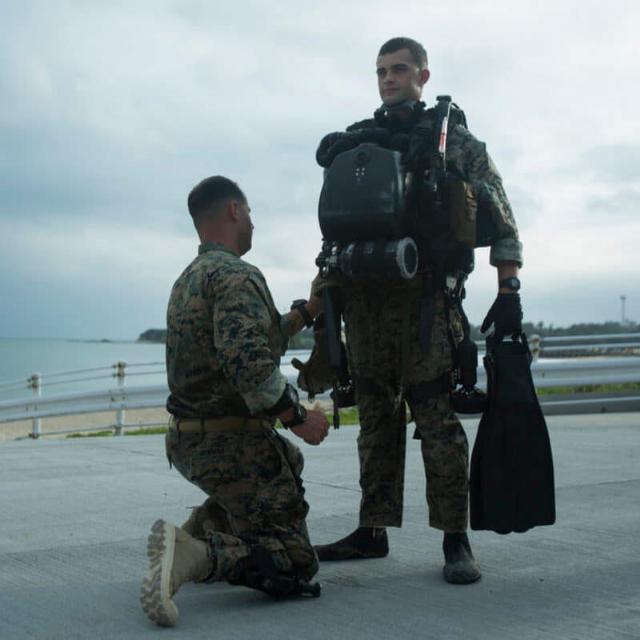
Like a water sled or a scooter, Jetboots reduces the risk of overwork when a combat swimmer stealthily approaches, significantly increasing speed and range. Unlike a diving sled, a swimmer has both hands free to manipulate objects or use weapons and reconnaissance equipment.
Compared to water sleds, Jetboots also provide better mobility and responsiveness. Jetboots can be integrated with the Dive Tablet 2 device and DiveLog navigation software from Shark Marine Technologies. This allows the swimmer to constantly monitor the battery level, remaining distance and estimated time of arrival to the target, as well as the current location and depth of the dive using a secure tablet.
Protective equipment
The SpN forces must be prepared for a variety of scenarios without overloading themselves with equipment. In particular, with regard to protective gear, they must find a balance between protection and mobility.
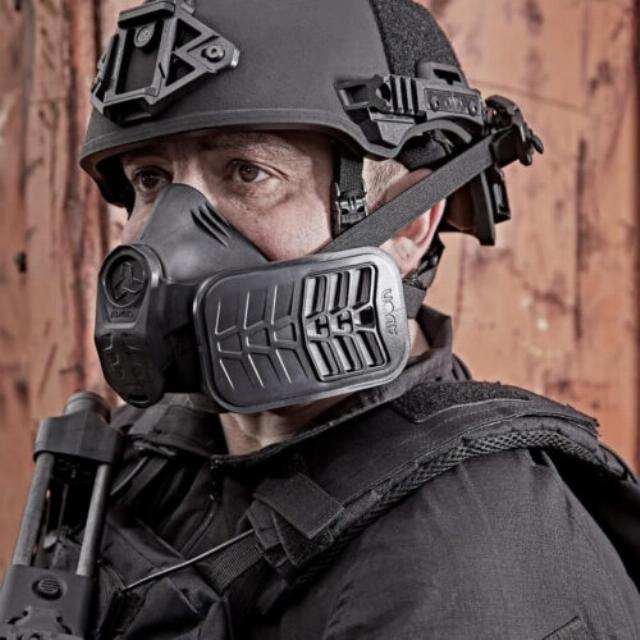
MITR-M1 half mask from Avon Protection
In February 2025, Avon Protection introduced the MITR-M1 half mask to protect against low- and medium-level respiratory threats. Advantages over full-face chemical respirators include lower weight and the ability to carry in a pocket or standard bag. It is designed to be used with helmet mounts, which allows the user to put on a mask without removing the helmet. The filter can be worn both on the left and on the right, so as not to interfere with aiming. According to Avon, the compact MITR-PF particle filter used in the mask provides a filtration efficiency of 99.97%.
The design of the half mask is designed not to interfere with other equipment, such as safety glasses or night vision devices (NVGS). In addition, Avon is developing MITR-PG1 powered glasses to complement the mask. In fact, it is a ballistic visor with a built-in filter and a blower system for constantly purging the air inside the glasses, protecting the eyes and preventing fogging.
Means of communication
Communication between the personnel of a deployed special forces unit, as well as between the unit and the headquarters or other military formations, is a factor that increases combat effectiveness. Networks are becoming increasingly necessary, and many users are increasingly using high-performance systems for special forces.
One example is the Gladius 2.0 Flex system, a specialized version of Rheinmetall's Gladius 2.0 system for special forces. Specifically, Flex is based on a lightweight version of Gladius 2.0 designed for light infantry, and includes a lightweight base kit consisting of a lightweight portable device with scalable ballistic protection, a radio for voice and data transmission with integrated blue force GPS tracking, a wired/Bluetooth headset for voice communication, and an end-user device. Which can be a rugged tablet, smartphone, or smartwatch capable of displaying tactical maps and exchanging tactical information. Flex adds special components to support MTR requirements.

The Gladius 2.0 Flex network system includes a device for displaying and exchanging tactical information.
According to Rheinmetall's definition, the equipment includes a "smart" control center that integrates additional components and provides energy and data management for the Gladius 2.0 Flex system. Instead of requiring each component of the system to have its own batteries, Flex subsystems are powered by a central battery pack, which simplifies logistics.
The head-mounted day and night vision display uses augmented reality (AR) to display important information. Finally, cable access allows the soldier's system to be connected directly to the vehicle, providing access to a power source, data exchange, communication with the vehicle, sensors, and actuators.
While Rheinmetall's Gladius system was acquired by the German Armed Forces, similar network systems are being acquired or developed by many armed forces. As a priority, special forces units will continue to implement new technologies that will enhance situational awareness and communication capabilities vital to their success and survival in the field.
According to the materials of the resource euro-sd.com

